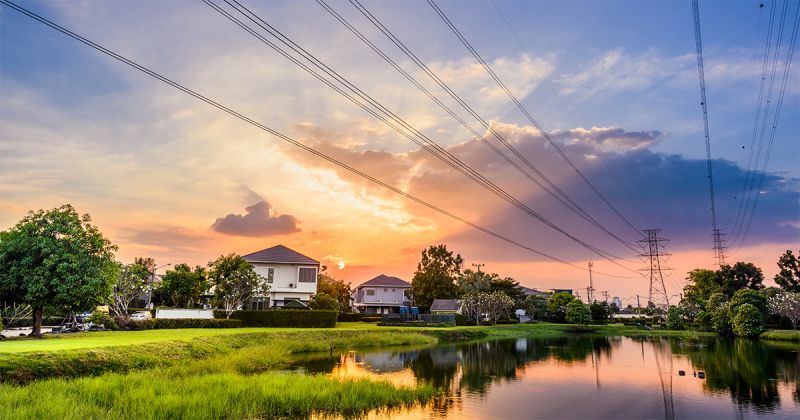
What You Need to Know About Power Line Safety
According to the Electrical Safety Foundation, electrical hazards kill 400 to 500 Americans and injure thousands more every year. Contact with overhead or downed power lines is a leading cause of these deaths and injuries, and the Foundation notes that the risks are especially acute during storms, which can bring down power lines. Case in point last year, when a Florida power line downed by Hurricane Idalia killed an Alachua County man.
Hurricane season is upon us again, so the professional Tallahassee electricians at Meeks Electrical Services thought it would be a perfect time to review power line safety tips. Even though you can look out your window and see some, you probably give little thought to power lines. Aloft and out of reach, they line our highways and streets with splinter lines that deliver power to residences and businesses effortlessly. They are fundamentally safe but inherently dangerous, especially if touched the wrong way or downed by a storm or other event. Read on to learn what you need to know about power line safety.
Power Line Basics
The distribution power lines you see on your street typically use between 4,000 to 69,000 volts to deliver an electrical current of a few hundred to several thousand amps, while the distribution line feeding power to your home uses 120/240 volts to deliver 100 to 200 amps. Touching these lines can cause serious injury or death. Consider that even a low 0.1 to 0.2 amperage current passing through the heart can be fatal, and a 50-volt shock can be lethal under the right conditions. The degree of injury or death one might face by touching a power line depends on several factors beyond voltage, including:
- The amount of electrical current (amperage).
- The path the electricity takes through the body (whether it passes through vital organs).
- The body’s potential resistance, as influenced by skin condition, moisture, and clothing.
- The presence of water, which can reduce the body’s electrical shock resistance.
- Duration of contact.
The bottom line is you should always avoid direct or indirect contact with power lines, whether on the street or serving your home. In fact, you should always keep your distance from power lines because electricity can arc from a power line to nearby people and objects.
Power Line Safety Around the Home
You’ll probably never have any reason to go near a street-side power line, but if you do, know that these lines are uninsulated and present a severe risk of electrocution. No one from your household should ever climb trees that are touching or close to power lines, and you should always be careful if using a ladder, pole, or any long tool that might come into contact with the lines.
While distribution lines going into the home are—unlike street-side power lines—typically insulated to protect against shock, such insulation deteriorates, cracks, and otherwise loses its insulating properties over time. Therefore, you should always treat your home’s power lines as if they were uninsulated. When engaged in outdoor home maintenance chores, always be aware of where the line run, and avoid personal or secondary contact.
Power Line Safety During Storms
Storms significantly enhance the potential threat posed by power lines because they can bring the lines down, and stormwater conducts any electricity flowing from downed power lines. A live downed wire will deliver electricity through the ground and surrounding water in all directions. If it’s touching a chain-link fence, metal culvert, or other conductive material, those objects will be energized, as well. There is no way to tell whether a downed power line is energized, so you should always keep your distance if you see one and know that even if not energized, it could become live during power restoration efforts.
Walking through a storm’s floodwaters is dangerous because you may not be able to see a downed power line, and damaged lines could be hiding in tree limbs or other storm debris. If a powerline falls on your car during a storm, stay inside it and don’t touch anything metallic. Your car’s tires should provide enough insulation to keep you safe, but if you exit the vehicle, you risk electrocution from the car and the surrounding ground. If possible, call 911 to report your problem and wait for help. If you must exit the vehicle due to a fire, try to jump clear by avoiding touching the ground and car at the same time, and then shuffle away with your feet together to minimize the risk of shock.
Other Power Line Safety Tips
Other power line safety tips to keep in mind during storms or any time include:
- Always check the power lines near your home before venturing outdoors during or after a storm.
- Never touch anything hanging down from a power line.
- If you ever see someone who is being shocked by a power line, do not try to pull them away; you will get shocked, too. Instead, call 911.
- If you see a downed, sagging, or damaged power line, immediately call your utility or emergency services to report it and try to warn others of the potential danger.
Contact Meeks Electrical for Your Electrical Needs
We trust that these safety tips will help keep you and your family safe during storms or in any connection with power lines. If a storm or other issue has caused problems with your home’s electrical needs, we also stand ready to resolve them. For all electrical service needs in the Tallahassee area, contact us at (850) 575-5241.